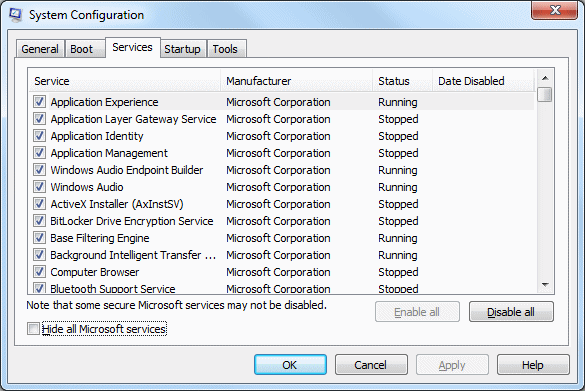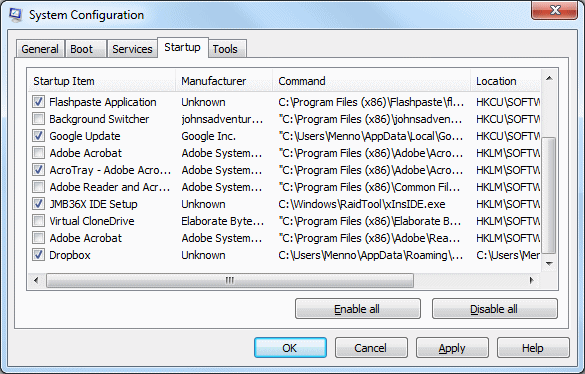
The System Configuration tool MSCONFIG has different options and settings to make changes to the Windows 7 startup procedure. This tool can be used to disable or enable programs and services which are loaded at the startup of Windows. Tweaking the startup procedure can significantly speed up the time to boot the PC and save system resources. To start the tool, use the command MSCONFIG in the field Search programs and files of the Start menu. If Windows has just been reinstalled, there won't be much programs or services to disable. However it is still interesting to have a look whether there are still some items to be optimized.
Tab Services
The tab Services shows the services which are started automatically at
Windows startup. Most services are necessary for Windows, it is better not to
change them. By activating the option Hide all Microsoft services, these
(mostly) essential Microsoft services are hidden (this makes it easier to
identify unnecessary services). Actually, MSCONFIG is
not the appropriate tool to make changes to the startup items on the tab
Services. Use the default editor for services (opened with the command SERVICES.MSC)
instead. Visit the page
Windows 7 services
for detailed information which services are safe to disable.

Tab Startup
The tab Startup shows all the programs which are loaded at the
startup of Windows. There are many programs which place a link here during the
setup procedure, to make sure that (a part of) the program is loaded at startup.
For each item you have to find out whether this is a desired behavior. If a
program is deactivated, it can still be reactivated afterwards.

|
|
After closing MSCONFIG the user is asked to reboot the computer. After Windows has been restarted, the user is informed by a System Configuration Utility popup that startup items have been disabled. This popup is shown every startup till the user checks the option Don't show this message or launch the System Configuration when Windows starts.
ATTENTION: If there is a virus among the startup items, stop the process first using the Task Manager (CTRL-SHIFT-ESC) to prevent the virus from reactivating the virus after closing MSCONFIG. When disabled items are reactivated automatically after startup, start MSCONFIG in safe mode to prevent the program from activating itself. Safe mode is activated by pressing F8 at the beginning of the Windows startup procedure.
DELETING STARTUP ITEMS MANUALLY FROM THE REGISTRYIf a startup item is not necessary for the specific use of the computer,
deleting from the startup list is also possible by deleting the registry value
permanently from the registry (see
the column Location of MSCONFIG). Start the registry editor, go to
the following registry keys and delete the unwanted registry values: Deleting registry values is permanent! Export the registry values to a REG-file first, to be able to recover the registry values (double clicking the file will import them into the registry). |
A GOOD OVERVIEW OF THE STARTUP ITEMSBecause MSCONFIG is not that informative, it is sometimes better to use the tool AutoRuns (download: www.microsoft.com). This tool gives more information about the automatically started programs (like the location where to find them in the Windows Explorer). The tool Process Explorer (download: www.microsoft.com) is also very useful to identify startup problems because this tool makes it possible to investigate the running processes. See the page about the Sysinternals system tools for more information. |
CHECKING OUT PROCESSESVisit www.processlibrary.com to find out if it is not obvious what an installed program is used for (is it a trojan or not). |
Systematically solving startup problems
The cause of a startup problem like a blue screen (Blue Screen of Death; BSOD)
is sometimes simply found by using the tool MSCONFIG. First make notes
which items on the tabs
Startup and
Services are disabled and enabled before making changes to these items! The next
step is to disable all items on the tab Startup and all non-Microsoft services on the tab Services.
Restart the computer and check whether all disabled items are still disabled (if
not, it is an indication of a virus). If not all items are disabled, start
MSCONFIG while Windows is in safe mode (press F8
while booting Windows). Tactically reactivate items (start with the tab Services)
and reboot the computer. Continue these steps, until the item which causes the
problems, is found. The page about
disabling/removing unwanted software
offers additional information concerning this subject.
Removing an old installation from
the boot menu
If Windows 7 is reinstalled without deleting the old installation (by
partitioning
and
formatting),
in most cases the boot menu shows two entries (the old operating system is still
visible in the boot menu). To remove the older version from the boot menu (and the
hard drive), first make sure the new version is the default operating system to
start the computer. The next step is to remove the older version from the
boot menu and to delete the installation folder using the Windows Explorer. These
changes can be made with the command BCDEDIT, but it is easier to use the
tool EasyBCD
(download:
www.neosmart.net/dl.php?id=1).
Damaged boot sector
If Windows does not boot anymore, it is possibly caused by a damaged
boot sector. To repair the boot sector, insert the Windows installation DVD (or
a system repair disc created by the item Backup and Restore in the
control panel, task Create a system repair disc) and restart the computer. Run the setup, select the language settings and select Repair your
computer, select the Windows 7 entry, click Next and select Command
prompt. The command BOOTREC /fixboot will fix the boot procedure. The
command BOOTREC /fixmbr will fix the Master Boot Record (MBR).
The command EXIT
will end the recovery console.
© 2001-2022 - Menno Schoone - SchoonePC - Rotterdam - The Netherlands